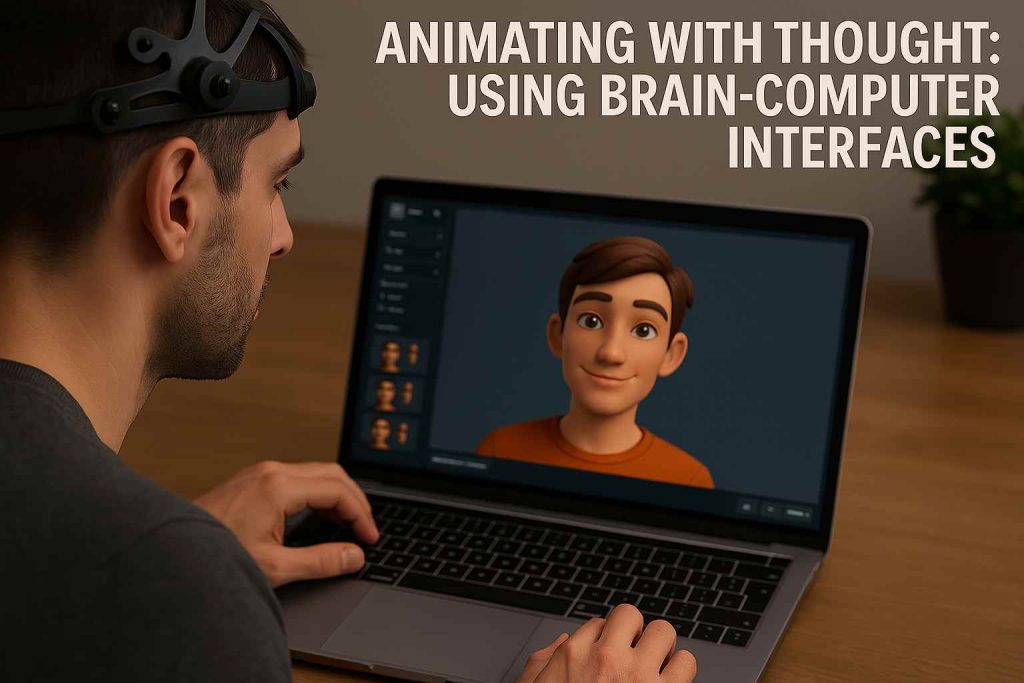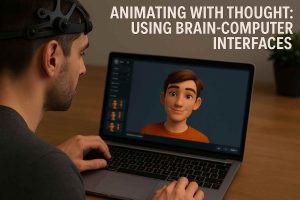
In the ever-evolving landscape of gaming technology, the fusion of brain-computer interfaces (BCIs) with 3D animation presents an innovative frontier. This integration allows players to engage with games on a neurological level, transforming the way we interact with virtual environments. For game developers, video game journalists, and content strategy managers, understanding this cutting-edge technology is crucial to staying ahead in the gaming industry. This article delves into the intricacies of EEG integration, explores the challenges and opportunities presented by BCIs, and outlines the future potential for Unity developers in this new era of gaming.
Exploring EEG Device Integration in Unity
The essence of integrating electroencephalogram (EEG) devices with Unity lies in capturing neural signals and translating them into actionable game mechanics. This process begins with EEG devices detecting electrical activity in the brain, which is then processed by algorithms to interpret the player’s intentions or emotional states. By connecting these signals to Unity’s animation framework, developers can create dynamic, responsive 3D animations and story branches that react in real-time to a player’s mental state.
Understanding EEG Technology
EEG technology is at the heart of brain-computer interfaces. It involves monitoring the brain’s electrical activity through sensors placed on the scalp. This data is then analyzed in real-time to determine patterns that correspond to specific thoughts or emotions. Understanding the intricacies of EEG signal capture and interpretation is crucial for developers looking to utilize this technology effectively.
Translating Neural Signals into Game Mechanics
The translation of neural signals into game mechanics involves sophisticated algorithms that interpret the raw EEG data into actionable insights. This requires a combination of neuroscience and computer science knowledge to ensure that the interpretations are both accurate and meaningful. Developers must be adept at creating algorithms that can differentiate between different mental states and translate these into corresponding game actions or animations.
Implementing Real-Time Reactions in Unity
Once EEG signals are interpreted, the next step is to implement real-time reactions within Unity. This involves using Unity’s animation and scripting capabilities to trigger changes in the game environment based on the player’s mental state. The challenge is to ensure that these transitions are seamless and do not disrupt the gameplay experience. This requires a deep understanding of Unity’s real-time processing capabilities and how to optimize them for BCI integration.
Brain-Computer Interfaces for 3D Animation: Challenges and Opportunities
While the potential of BCIs in gaming is vast, it is accompanied by unique challenges. The accuracy of EEG readings is contingent upon factors such as device quality and environmental noise, which can affect the reliability of the data. Developers must also navigate the complexities of translating abstract neural signals into coherent game actions without compromising the player’s control or experience.
Addressing Device Limitations
One of the primary challenges in BCI technology is the limitation of current EEG devices. These devices must be both accurate and comfortable for users to wear for extended periods. Developers must work closely with hardware manufacturers to ensure that the devices provide high-quality data while remaining user-friendly. This might involve developing new sensor technologies or refining existing ones to improve signal accuracy and reliability.
Enhancing Signal Processing Algorithms
Optimizing signal processing algorithms is crucial to overcoming the inherent noise in EEG data. Developers can employ machine learning techniques to refine these algorithms, allowing for more accurate interpretation of neural signals. By continuously improving these algorithms, developers can ensure that the game responds appropriately to a wide range of cognitive inputs, enhancing the player’s sense of control and immersion.
Balancing Immersion and Control
Creating a seamless gaming experience requires balancing the depth of immersion provided by BCIs with the player’s need for control. Developers must design gameplay mechanics that are intuitive and responsive, ensuring that players feel connected to the game without being overwhelmed by the technology. This involves careful consideration of how BCI inputs are integrated into game design and how they complement traditional control methods.
The Future of Gaming: Unity Developers for Hire
As the demand for immersive and interactive gaming experiences grows, so does the need for skilled Unity developers who can harness BCI technology. By specializing in this niche, developers can position themselves at the forefront of the gaming industry’s next evolution.
Essential Skills for Unity Developers
Aspiring Unity developers should cultivate a deep understanding of both the technical and creative aspects of game development. Proficiency in C# programming, familiarity with EEG signal processing, and an aptitude for crafting compelling narratives are essential skills in this domain. Additionally, developers should be well-versed in the latest advancements in neuroscience and machine learning to effectively integrate BCIs into their projects.
Opportunities in Various Gaming Sectors
With the integration of BCIs in gaming still in its nascent stages, there are abundant opportunities for developers to make a significant impact. From indie studios experimenting with novel game mechanics to large gaming corporations seeking to enhance their flagship titles, the demand for BCI-savvy Unity developers is on the rise. Developers can explore opportunities in a wide range of sectors, including therapeutic gaming, educational applications, and interactive storytelling.
Shaping the Future of Interactive Entertainment
By pursuing a career in BCI-integrated game development, Unity developers have the chance to shape the future of interactive entertainment. This involves redefining the boundaries of player interaction and creating experiences that are not only entertaining but also intellectually stimulating. Developers who embrace this technology can become pioneers in a rapidly evolving industry, leading the charge toward more immersive, thought-provoking gaming experiences.
The Role of Brain-Computer Interfaces in 3D Game Animation
Brain-computer interfaces (BCIs) hold immense potential to revolutionize 3D game animation by providing a direct link between a player’s thoughts and the on-screen experience. This technology enables game characters to respond dynamically to a player’s mental state, resulting in an unprecedented level of interactivity and emotional engagement. In this section, we explore how BCIs can enhance the animation process, leading to more lifelike and responsive characters.
Dynamic Character Animation
With BCIs, developers can create characters that not only react to inputs but can also sense and adapt to a player’s emotions in real-time. This dynamic character animation can enhance storytelling by allowing characters to express emotions based on the player’s neural signals. For example, if a player feels excitement, a character might exhibit animated joy, while feelings of tension could prompt a more guarded or defensive stance.
Nuanced Facial and Body Expressions
BCIs can facilitate the capture of subtle variations in a player’s emotional state, which can be translated into nuanced facial and body expressions for characters. By interpreting brainwave patterns, developers can implement algorithms that adjust a character’s animations accordingly. This capability ensures that animations are not only visually appealing but also closely aligned with the player’s current emotional experience, enriching the overall gaming experience.
Creating Personalized Gaming Experiences
The integration of BCIs into 3D animation opens doors to personalized gaming experiences. Developers can use the data gathered from player interactions to tailor character animations to individual preferences. This personalization could lead to unique gameplay experiences where characters evolve based on a player’s emotional reactions over time, creating a deeper connection between the player and the game world.
By incorporating BCIs into 3D game animation, developers can push the boundaries of traditional gaming, crafting experiences that resonate more profoundly with players on both emotional and cognitive levels. As this technology continues to mature, the potential for innovative storytelling and gameplay in 3D environments will only expand, paving the way for a new era of interactive entertainment.
Conclusion: A New Era of Gaming
The convergence of brain-computer interfaces and 3D animation in Unity heralds a new era of gaming, where players can transcend traditional input methods and interact with games on a cerebral level. For game developers, video game journalists, and content strategy managers, embracing this technology offers a pathway to innovation and engagement. By understanding the intricacies of BCI integration and its potential applications, stakeholders in the gaming industry can pave the way for more immersive, personalized, and thought-provoking gaming experiences.
Embracing the Intersection of Neuroscience and Gaming
In this exciting intersection of neuroscience and interactive entertainment, the possibilities are boundless. As we continue to explore and refine these technologies, the gaming landscape will undoubtedly transform. This transformation promises players experiences that are not only entertaining but also intellectually stimulating, offering a deeper connection between the player and the game world.
The Role of Stakeholders in Advancing BCI Technology
Stakeholders in the gaming industry, including developers, marketers, and content creators, play a crucial role in advancing BCI technology. By investing in research and development, fostering community engagement, and sharing knowledge, they can drive the innovation needed to bring BCI-integrated games to the mainstream. This collaborative effort will be key to unlocking the full potential of brain-computer interfaces in gaming.
Looking Ahead: The Future is Now
As we look ahead to the future of gaming, it is clear that the integration of BCIs will be a defining aspect of the industry’s evolution. With continued advancements in technology and a growing community of developers and players eager to explore new frontiers, the future of gaming is bright. By embracing the possibilities of BCI technology today, we can shape a gaming landscape that is more immersive, interactive, and engaging than ever before.






